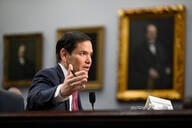You have /5 articles left.
Sign up for a free account or log in.
Former Florida Governor Jeb Bush this week outlined a higher education plan calling for drastic changes to how the federal government provides financial aid to students enrolling in colleges and universities.
As he looks to stand out in a crowded Republican primary field and distinguish himself from rivals like Senator Marco Rubio, who is the only other GOP contender with a full-fledged higher education plan, Bush on Monday unveiled a set of policy proposals that his campaign said would “transform” higher education. Bush had promised such a plan for months and it now comes as he significantly trails many of his rivals in the polls.
In 2015, Bush criticized plans by Democratic candidates to fund debt-free or tuition-free college, and he has drawn criticism for his remarks questioning the value of majoring in psychology and other liberal arts fields. But his platform released Monday outlines in much greater detail -- though with few specific cost figures -- how he would approach higher education as president.
New Federal Loan System
Bush’s plan would eliminate the federal student loan program in its current form in favor of a new financing structure that is tied to students’ income. Under the plan, the federal government would provide each high school graduate with access to a $50,000 line of credit to pay for college or career training.
Borrowers would then repay whatever amount of that credit they spend through their federal income taxes over 25 years. The payments would be set at 1 percent of their income for each $10,000 they borrow.
Bush said that low-income students would be able to receive their Pell Grant on top of the $50,000 line of credit, though he said he would like to see some reforms to the program, including notifying students of their Pell eligibility far earlier.
“This new financial aid system would eliminate the confusing financial aid application process and remove the menace of accumulating interest, default, damaged credit and collections agencies,” Bush’s plan says. “It would ensure that repayment is predictable and affordable, protects students during periods of unemployment or underemployment, and eliminates defaults.”
His plan also calls for borrowers with existing student loan debt to be able to transfer into his new system. For borrowers who decide not to, Bush said his plan would help ease the transition of borrowers into President Obama’s expanded income-based repayment program, known as REPAYE.
Bush also said that he wanted to change federal bankruptcy law to allow private student loan borrowers to more easily discharge their debt in bankruptcy. The Obama administration made a similar proposal late last year.
Accountability and Data
Bush’s plan also seeks to hold colleges and universities more accountable for their costs and student outcomes by forcing them to repay a share of the federal loans their former students are unable to repay.
“This will incentivize them to reduce costs and ensure that students graduate with the skills needed to succeed,” Bush wrote in a post on Medium.
This idea to give colleges “skin in the game” in the federal student loan program has bipartisan support in Congress, at least in concept. And Hillary Clinton last year included a similar proposal in her higher education platform.
In addition, Bush said he would create state databases that track student outcomes in higher education programs, including the unemployment rate, postcollege earnings, graduation rates and debt repayment rates.
“We need students to be able to judge the cost and quality of programs so they can make better choices and hold schools accountable,” he wrote.
Although such proposals have been politically controversial at the federal level -- with opposition mostly from conservative Republicans and private colleges -- Bush’s plan for state-driven data systems echoes efforts that are already underway in many states.




